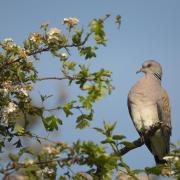Choosing and looking after the right pet for your child might be more challenging than you think

The thought of owning an animal is appealing to many children, with rabbits, guinea pigs, gerbils and hamsters often chosen as an initial pet experience. However, according to Sarah Clarkson, supervisor for small animals, cats and dogs at RSPCA Leybourne, preconceived ideas you might have about what these popular small creatures actually need should be re-evaluated.
For parents who think looking after these animals is easy or if the lifestyle of the family is ignored and a resultant wrong choice is made, rehoming a pet can be an unwelcome reality.
The RSPCA works slightly differently to other charities in that it doesn’t take in animals from the public, but directly from inspectors who have collected them as a result of reports about a wide range of welfare concerns such as abandonment and neglect. Rabbits are currently at the top of the list when it comes to the type of small animal arriving at the charity’s West Malling doors.
“Rabbits don’t get a lot of recognition about how much space they actually need and how complex an animal they are. I wouldn’t recommend them for very young children and although they can make good pets, people really need to fully understand what they require. They need a lot of space, a lot of mental stimulation and the companionship of another rabbit. If they are just shoved into a small hutch without the appropriate care they can get very frustrated very quickly,” explains Sarah.
She adds that a rabbit’s diet can be complex because they have an unusual digestive system and if this is ignored, they can get tooth problems.
A rabbit should also be able to stand up in its hutch and be able to hop at least three times, as well as having a secure exercise area.

“If people are willing to put in all this work there is no reason why parents can’t let their children have rabbits as pets, they just need to be fully aware that they can’t just let their children pick them up and let them do all the caring by themselves.”
Small pets often require a companion, but keeping multiple pets must also be considered carefully. For example, Sarah says rabbits kick out when they are angry and can cause a lot of damage with their back teeth, so putting a rabbit with a guinea pig is not a good idea.
“Obviously rabbits have to live together, so if you have a male and wanted to get him a friend, then you would have to get him neutered and wait several weeks while his hormones calm down. Bear in mind when you are pairing rabbits it can be difficult and isn’t always successful.
“Female guinea pigs are very sociable and generally you can just put females in together as long as they have enough room to get away and explore. If you have a neutered male, they generally accept any number of females as long as they have got enough space.
“But with male guinea pigs, unless you mix them from an early age then you can’t put two adult males together as they would just fight.”
Guinea pigs are also high on the rehoming list at the RSPCA Leybourne and Sarah says they are a much easier pet for children to manage and care for in comparison to rabbits.

“They are generally less skittish than some rodents, they have great personalities and are always chattering. Guinea pigs can be picked up and are a lot smaller than rabbits. If you have multiple guinea pigs, we say you need a 5ft or a 6ft x 2ft x 2ft hutch plus an exercise area.”
Hamsters are a very popular choice for a child’s first pet, but Sarah says children need to be aware that a lot of rodents are nocturnal, so daytime play is not appropriate.
The highly intelligent and sociable rat can make a good pet, she adds, and although the RSPCA centre gets a lot of very timid, nervous ones in, they can be great for an older child who can take the time to build their confidence. Rats can build very strong bonds with their owners, but again they do need to live in groups.
“The bigger the accommodation you can provide the more rats you can keep. You can keep multiple females together and unless males are mixed from an early age you can’t put them together as adults unless they are castrated.
“You can teach them to do tricks – they’re very inquisitive – so it’s great for children to furnish their cages with lots of enrichments like hidey holes, things to shred and to get them to forage.”
Sarah says if handled correctly from an early age ferrets can also make a good pet. “Ferrets can be great if you can’t have a dog or a cat at your property, they can be litter trained and they can live in a hutch-type cage environment outside with an additional run as well.

“They are very clean and although some people say they smell, once they have been neutered the smell generally disappears.”
Sarah says when it comes to cats there is much to consider, particularly if a family plans to buy a kitten, which can’t be left alone for long hours as they need feeding, interaction and socialisation.
“Cats can make great pets, but children need to understand when to give them time alone, when to approach them, when not to approach them. The same goes for dogs.
“Typically, if a cat is unhappy they will go off – so if you have a child who is constantly pestering and harassing the cat, it won’t stick around.”
Growing up with animals in the home can reap many rewards for both the owner, children and of course the pet itself as long as adults carefully consider the needs of everyone and every pet involved. Sarah says one of the positive outcomes for a child is learning about responsibility, although ultimate responsibility must rest with the adult. “Other benefits of pet-ownership for a child include improving a his/her social skills, creativity and teaching empathy towards others as well as broaching the subject of death.
“Some children find companionship in a pet as well as comfort, support and security and a pet can often ease anxiety for a child and bring a child out of themselves as well as reduce stress.”
For more information, visit www.mypetpalsacademy.com, a free online resource set up by the RSPCA and Pets at Home, to learn about what an animal needs to be happy.
For information on adopting an animal from the RSPCA, visit www.rspca.org.uk
Rat facts
Living accommodation: Multiple rats need a minimum space of 3ft. x 2ft. x5ft. Rats are very clean so give them a place to toilet. Place in an area of the house which does not get too hot or too cold.
Food/drink: Water bottle or bowl available at all times. They need a fresh/healthy/balanced diet by feeding balanced commercial pelleted diets. Rats are omnivores eating both plant and animal materials.
Human interaction: Never house individually, they’re social animals and can get depressed if alone. Rats need other rat company at night when they’re most active. Rats need to rest/sleep without being disturbed. Keep food provision/cage cleaning/interactions to dawn/dusk wherever possible. Don’t house them in areas which have lots of activity during the day.
Entertainment: They need a complex and enriched space, with a variety of horizontal and vertical barriers, objects, materials and structures to encourage them to explore and exercise, places to hide, climb and investigate at different heights, opportunities to dig tunnels/create burrows. Mental stimulation - consider training them. Rats can learn new information/tasks and remember them over time.
General care: Rats are quite clean and will defecate in one area, this should be spot cleaned daily and full clean weekly. Checking rats regularly/carefully by a vet (annually) to ensure they’re happy/healthy. Common problems include tumours (especially females)/breathing problems/obesity/overgrown teeth. Small behavioural changes can indicate something is wrong.
Personality: Handled correctly can be outgoing, fun and have great personalities.
Life expectancy: two to three-and-a-half years
Guinea-pig facts
Living accommodation: Need a minimum of 5ft. x 2ft. x 2ft. hutch with an additional exercise run outside on grass.
Food/drink: Unlimited access to water either with a bottle or bowl. Unlimited hay/grass. They can suffer from vitamin C deficiency so they need a variety of fresh veg/fruit. Also require a complete pellet food but this should be limited to their daily allowance.
Human interaction: Can be really sociable with people of all ages if handled correctly. Should never be kept on their own or can become depressed. Good combinations include: neutered male and one/more females, two females, neutered brothers (if they’ve been reared together). Guinea pigs are active up to 20 hours per day and sleep only for short periods.
Entertainment: Need lots of enrichment to keep them happy. They do not dig or make burrows themselves but do use natural shelters, dense vegetation or the burrows of other animals as refuges therefore providing tunnels and lots of hidey holes is essential.
General care: Hutches need cleaning out regularly. Do not need any vaccinations but recommend annual vet checks for health. Incorrect diet can cause overgrown teeth issues.
Personality: With right handling they care chatty and outgoing with individual personalities, very clever and can recognise voices.
Life expectancy: four to eight years.
Rabbit facts
Living accommodation: Need a minimum of 6ft. x3ft. x2ft. hutch with an additional exercise run. Biology and behaviour of pet rabbits is very similar to that of wild rabbits. This means they have very complex needs.
Food/drink: Good quality hay and/or grass, always available, should constitute the majority of rabbits’ diets. Rabbits graze, naturally eating grass/other plants for long periods, mainly at dawn and dusk. Rabbits’ digestive systems need grass and/or hay to function properly. Rabbits become overweight and may suffer if eating more food than needed. Rabbits only need a small amount of pellets. Avoid muesli-style foods as they are associated with health problems. Can only eat certain fresh veg and limited amounts. Certain foods are poisonous so always check before feeding.
Human interaction: Rabbits are naturally sociable preferring other rabbit company and being kept together. Rabbits can develop abnormal behaviours and may suffer if left to live a solitary life and with nothing to do for long periods. Caring by a responsible person to meet all their welfare needs, shouldn’t be left to children. Rabbits that are well handled by people from a young age can learn that humans are friends and companions.
Entertainment: Safe toys to play with/chew and regular opportunities to play with other friendly rabbits and/or people.
General care: They can be litter trained and this needs to be changed daily especially in the summer when prone to fly strike. Complete bedding changed when needed.
If eating/drinking habits change/quantity of droppings reduce/stop, ask your vet immediately - they could be seriously ill. Illness is often down to incorrect diet. Gut stasis in rabbits is a huge issue and relatively unknown by owners. Their front teeth/nails should be checked at least weekly - these grow quickly. Only vets should correct overgrown/misaligned teeth. Incorrect diet is the main cause for poor teeth, Rabbits are vulnerable to infectious diseases/illnesses, especially dental disease. Veterinary check-ups at least annually. Consider pet insurance to cover veterinary treatment. Ideally should be microchipped.
Personality: Rabbits receiving little handling early in life, or roughly handled at any age, may find human contact distressing. This can be expressed as fearfulness/escape behaviour/aggression.
Life expectancy: eight to 12 years.
Syrian Hamster facts
Living accommodation: Syrian hamsters live solitary lives, cannot live in groups. Need a minimum 2ft.6” x 1ft.3” x 1ft.3” hutch. A comfortable, dry, draught-free, clean place to live, in a quiet place where they can rest undisturbed. Make sure they are not exposed to draughty or damp conditions.
Food/drink: A good quality, balanced diet containing all essential nutrients and minerals - a compound pelleted ration. Eat a mixture of seeds/cereals/insect larvae/larger insects. Small quantities of greens/cleaned root vegetables/pieces of fruit. Don’t give grapes or rhubarb as these can be poisonous to rodents.
Human interaction: Hamsters are often a child’s first pet. However, their needs are actually very complex and they can be easily injured by inept handling. Hamsters are timid animals, and although they can become accustomed to careful handlers, they become frightened and aggressive if they feel threatened. Hamsters enjoy interacting with people who handle them carefully, and are sympathetic to their needs. They are nocturnal so handling late at night or early in the morning is best.
Entertainment: Hamsters need a lot of room (especially at night), so buy as large a cage as you can. They naturally build nests. A running wheel can help, but additional opportunities are also necessary. They can run up to five miles a day.
General care: They need cleaning out regularly; do not allow the bedding material to become damp or smelly. Consult the vet immediately if they show signs of illness. They can be affected by many diseases; tumours aren’t uncommon, especially along the underside of the abdomen. They can become infected by contaminated food/water/litter material.
Personality: Can be entertaining.
Life expectancy: two to three years.
Gerbil facts
Living accommodation: Require a minimum of 3ft. x 1ft.3” x 1ft.3” for one to two gerbils. Larger accommodation if in larger groups. Ideally a gerbilarium so they can dig! A gerbilarium needs to be large enough to provide shelter, opportunities to dig and space to exercise, with adequate bedding and nesting material.
Food/drink: Fresh water available at all times. A good quality, balanced diet from a complete commercial food. Follow the manufacturer’s guidance for how much to feed. Fruit and vegetables can be used to supplement your gerbils ration. Do not give your pets’ grapes or rhubarb as these are poisonous to rodents. Gerbils love to hoard food in large stores.
Human interaction: Never leave your gerbils out of their gerbilarium unattended or overnight. They are quick. Don’t necessarily need human interaction.
Entertainment: Space to exercise, play together and have appropriate enrichment at all times of the day and night. A running wheel can help with this, but additional opportunities are also necessary.
General care: Need cleaning our regularly. Gerbils behaving differently to normal can indicate something is wrong; so this helps you notice signs of illness/pain, and take action quickly. Gerbils can be affected by many diseases. They can become infected by contaminated food/water/litter material. Inappropriate environments and/or stress, can lead to repetitive behaviours developing.
Personality: Very inquisitive, entertaining and great for kids wanting to create fun environments for them to explore.
Life expectancy: two to four years.
Ferret facts
Living accommodation: Minimum 6ft. x 3ft. x 2ft.6” for one to two ferrets. Additional run/exercise area. Daily exercise opportunities to stay fit and healthy - ideally daily access to a safe play area.
Food/drink: Fresh water at all times. A balanced diet suitable for their age, health status, level of activity. Ferrets are strict carnivores – they need a well-balanced, meat based diet. Usually a commercially designed ferret food is adequate. Ferrets have high metabolic rates, so they need to eat little and often. Food should be available at all times. Only give your ferret treats in small amounts.
Human interaction: To be kept with at least one other friendly ferret, they are very social animals. Daily handling from an early age – they can form strong bonds with humans. If carefully introduced early in life, ferrets can also develop friendships with other animals (non-prey species), and daily interactions with them can be beneficial.
Entertainment: Food offered in several ways to stimulate foraging behaviour and make them work for their food or treat, e.g. by hiding food or by using food toys. Constant access to safe hiding places (e.g. tunnels, closed hammocks) so they can avoid things that scare them. Ferrets are curious - play and exploratory behaviours are essential behaviours for them.
General care: Changes in behaviour or showing regular signs of stress/fear could indicate distress, boredom, illness or injury - seek advice from a vet. Signs of discomfort/pain include reluctance to move, weight loss, anorexia, trembling, collapse, crying, whimpering, and teeth grinding. Vet checks annually (at least) to check for diseases and for vaccination against canine distemper. Ferrets are vulnerable to many infectious diseases. Some diseases e.g. flu, can be passed between ferrets and people. Regular grooming to keep their coat in good condition. Ideally should be microchipped.
Personality: Handled from an early age they can be fun and inquisitive. They are entertaining in their play with each other and can interact with humans well.
Life expectancy: seven to ten years.
Cat facts
Living accommodation: Cats need a safe, hazard-free, stress-free environment. There are many different home situations and would be unfair to say each cat needs the same environment. However, every cat should be given the opportunity to express its natural behaviours. Consider access to suitable litter tray, safe hiding places to run to when scared, suitable toys/ depending on age, giving them the opportunity to play, hunt, run, jump and climb. Somewhere safe for them to sleep.
Food/drink: Fresh water should be available at all times, Cats need a well-balanced, meat-based diet to stay fit and healthy. Make sure your cat eats a balanced diet that is suitable for their age, health status and lifestyle. Cats naturally eat several small meals per day. There are a lot of commercial feeds on the market with a varied cost.
Human interaction: Cats need interaction. If you cat is left without company or entertainment for long periods, they are likely to suffer. Cats sleep for many hours of the day, but when they’re awake they need opportunities to exercise. If they don’t go outside, provide suitable indoor activities to keep them active. Kittens will naturally need more attention and therefore cannot be left for long periods.
Entertainment: Depending on the age they will need different types of play, activities, games.
General care: Litter trays need changing daily. Grooming regularly especially for long haired breeds. Cats have similar pain thresholds as people. They are vulnerable to a range of infectious diseases or illnesses. They need neutering, annual vaccinations, regular flea treatments and wormers. They should be microchipped. Insurance is highly recommended.
Personality: Cats have very different personalities it is important to match these correctly to the family. In the right home a cat can be a lovely addition.
Life expectancy: 15 to 20 years.



























